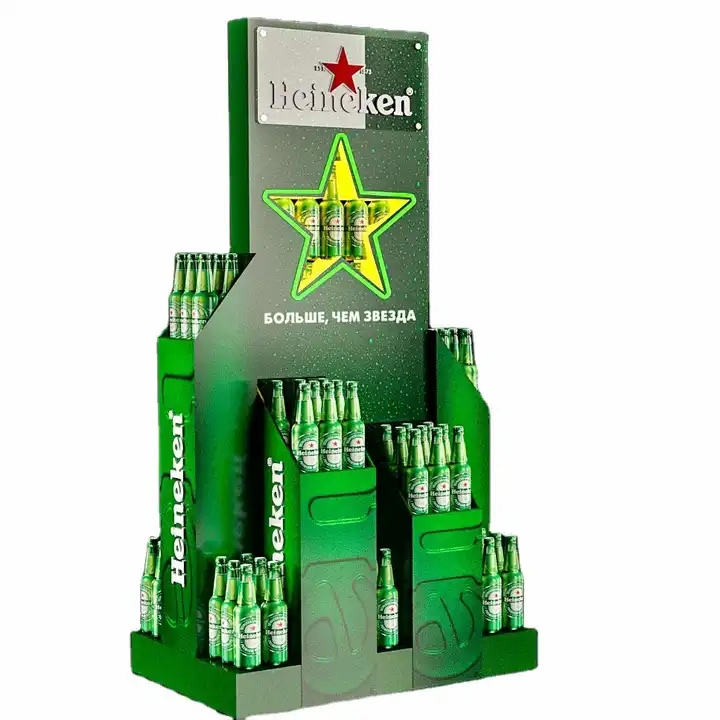Content Menu
● Understanding Display Stands
● Types of Display Stands and Their Uses
>> Floor-standing Display Units (FSDUs)
>> Countertop Display Stands
>> Display Cases and Showcases
>> Banner and Poster Display Stands
>> Literature and Brochure Stands
>> Gondola and Isle Units
>> Slatwall and Gridwall Display Stands
>> Dump Bins and Pallet Displays
>> Modular and Portable Display Stands
>> Custom Display Stands
● Applications of Display Stands
>> Retail
>> Trade Shows and Exhibitions
>> Corporate and Offices
>> Museums and Galleries
>> Restaurants and Cafés
>> Special Events
● Choosing the Right Display Stand
● Benefits of Using Display Stands
● Tips to Maximize Display Stand Effectiveness
● Conclusion
● Frequently Asked Questions
>> 1. What are the most common types of display stands used in retail?
>> 2. How can I decide which display stand material is right for my products?
>> 3. Are custom display stands worth the investment?
>> 4. How do display stands influence customer purchasing decisions?
>> 5. Can display stands be reused for different campaigns?
Display stands form a crucial element in the marketing and merchandising toolkit of businesses worldwide. They serve not only as functional pieces for organizing and presenting products but also as powerful tools to catch the eye, convey brand stories, and influence customer interactions. Their importance spans across retail environments, trade shows, exhibitions, galleries, offices, and special events.
For companies like Shenzhen XingKun Packing Products Co., Ltd, specializing in custom packaging including display stands, understanding the diversity of display stands and their optimal uses is vital for delivering tailored OEM solutions to global brand owners, wholesalers, and manufacturers. This comprehensive article dives into the various types of display stands, their unique features, material considerations, and typical applications across industries, helping you make informed decisions and maximize product impact.

Understanding Display Stands
At their core, display stands are designed to showcase products, information, or promotional content in a visually accessible way. They function as a bridge between the product and the consumer, enhancing visibility, organizing merchandise efficiently, and reinforcing brand identity.
The materials used for display stands vary widely—ranging from lightweight cardboard and plastic to robust metal and polished acrylic. The choice depends on the product type, display location, desired aesthetics, and budget. Flexible customization options allow businesses to incorporate logos, vibrant graphics, messaging, and special finishes to draw attention and encourage interaction.
The right display stand influences customer behavior, emphasizing product features and offering convenience in browsing or engaging with the merchandise.
Types of Display Stands and Their Uses
Floor-standing Display Units (FSDUs)
These are large, free-standing units positioned strategically on retail floors. Floor-standing display units are known for their commanding presence and capacity to hold multiple products or promotional items on shelves, hooks, or trays.
Uses:
- Showcasing newly launched products
- Driving awareness of special promotions or seasonal campaigns
- Serving as focal points in high-traffic locations such as store entrances or aisles
They are often built with sturdy materials for stability and durability and can feature large-format, full-color graphics that make a bold statement.
Countertop Display Stands
Compact and designed for limited spaces like checkout counters or reception areas, countertop display stands focus on small, impulse-buy products or informational materials.
Uses:
- Displaying confectionery, small electronics, or accessories
- Promoting gift cards, product samples, or seasonal items
- Organizing brochures or loyalty program leaflets
Their size allows placement right at the customer's point of purchase, enhancing impulse sales.
Display Cases and Showcases
Built to protect and present valuable, fragile, or high-priced items, display cases typically incorporate glass or acrylic panels combined with illumination.
Uses:
- Showcasing jewelry, watches, or collectibles
- Displaying limited-edition electronics or luxury goods
- Presenting museum artifacts or fine art
These stands combine security with optimal visibility, often incorporating locking mechanisms and stylish designs.
Banner and Poster Display Stands
Often used for communicating messages rather than holding products, banner and poster stands are tall, slender structures that display promotional graphics, advertisements, or event schedules.
Uses:
- Trade shows and event signage
- In-store promotions supporting other displays
- Directional information in public spaces
They generally offer easy assembly and portability, making them ideal for temporary or traveling campaigns.
Literature and Brochure Stands
Designed to organize printed materials neatly and accessibly, literature stands come in various configurations—rotating, tiered, wall-mounted, or free-standing.
Uses:
- Holding product catalogs or flyers in stores and exhibitions
- Displaying magazines or newsletters in waiting areas or offices
- Distributing marketing collateral at trade shows
Their structured format encourages visitors to pick up pieces, enhancing brand engagement.
Gondola and Isle Units
Gondola units are familiar retail fixtures—double-sided shelving units positioned within aisles or store centers offering versatile product display options.
Uses:
- Merchandising a diverse range of products grouped thematically
- Creating promotional cross-merchandising zones
- Filling large retail floor spaces efficiently
Isle units are variations designed to be accessed from multiple sides, increasing product visibility.
Slatwall and Gridwall Display Stands
These vertical panels equipped with slats or grids accommodate hooks, baskets, or shelves that can be rearranged, allowing extensive flexibility.
Uses:
- Displaying apparel, accessories, tools, or electronics
- Adjusting for seasonal merchandise changes
- Maximize space by going vertical
Their modularity makes them a favorite in dynamic retail environments.
Dump Bins and Pallet Displays
Dump bins are open bins used for discounted, bulk, or seasonal items placed in high traffic locations to encourage spontaneous purchasing.
Pallet displays are typically large, pre-packed presentations on shipping pallets, often used in warehouse or big-box retail formats, designed for quick stock replenishment.
Uses:
- Seasonal sales or clearance promotions
- Bulk goods such as toys, snacks, or household essentials
- Large-format merchandising
They are cost-effective solutions for high volume product movement.

Modular and Portable Display Stands
These systems provide brands with maximum flexibility, consisting of components that snap or fit together, allowing different configurations for varying campaign needs. Portable stands emphasize lightweight design and ease of transport.
Uses:
- Frequent brand activations and traveling exhibitions
- Pop-up shops or temporary retail spaces
- Dynamic promotional events requiring fast set-up and break-down
They allow companies to adapt quickly and maintain consistent brand presentation across locations.
Custom Display Stands
For products or branding requirements that do not fit within standard formats, custom display stands offer personalized solutions. These are handcrafted or specially manufactured to align with product dimensions, target audience preferences, and brand aesthetics.
Uses:
- Exclusive product launches
- Trade show booths requiring unique presence
- Brands with distinctive visual identities or irregular product shapes
Custom stands may incorporate lighting, interactive features, or novel materials to create immersive experiences.
Applications of Display Stands
Retail
In retail, display stands fulfill multiple functions: presenting merchandise attractively, directing customer flow, highlighting featured items, and creating thematic zones. Effective use of stands increases shopper engagement, supports upselling, and enhances store ambience.
Trade Shows and Exhibitions
At trade events, the focus is on eye-catching design and efficient use of limited space. Display stands become mini showrooms that communicate brand values, showcase product ranges, and facilitate interaction through literature display, product sampling, or digital components.
Corporate and Offices
Display stands serve as organizational tools in corporate environments, used for brochure distribution, informational signage, awards showcases, and brand reinforcement within lobbies, meeting rooms, and offices.
Museums and Galleries
Protective stands displaying artifacts or art pieces enhance visitor experience through careful lighting and positioning, ensuring visibility without compromising security or aesthetics.
Restaurants and Cafés
Menu display stands, promotional sign holders, and table-top displays communicate specials, seasonal offers, and branding, improving the overall customer experience and sales.
Special Events
Events ranging from weddings to conferences use display stands for seating charts, schedules, sponsor advertisements, and informational signage, supporting smooth operations while contributing to event atmosphere.
Choosing the Right Display Stand
Selecting a display stand involves balancing several factors:
- Product Characteristics: Weight, size, and fragility dictate material and construction.
- Location and Available Space: Consider floor footprint, visibility angles, and customer movement.
- Branding Needs: Integrate logos, colors, and brand messages to unify visual identity.
- Flexibility and Reusability: Modular or portable stands offer adaptability for evolving campaigns.
- Budget: Evaluate upfront cost versus durability and marketing impact.
Attention to these details ensures the stand effectively connects with target customers and strengthens the overall brand presence.
Benefits of Using Display Stands
Display stands provide multiple strategic advantages:
- Enhanced Visibility: Properly designed and positioned stands bring products into focus.
- Professional Presentation: They elevate product perception through organized, branded displays.
- Sales Growth: By capturing customer interest, stands stimulate purchases, both planned and impulse.
- Space Optimization: They create efficient use of retail or event space, accommodating diverse product types.
- Brand Consistency: Graphic and structural customization reinforce brand image.
- Convenience: Well-arranged displays improve customer navigation and staff maintenance.
Tips to Maximize Display Stand Effectiveness
- Use high-contrast, readable graphics for quick impact.
- Incorporate lighting to draw attention, especially for premium items.
- Combine multiple stand types for a layered shopping experience.
- Refresh visuals regularly to maintain interest.
- Position stands strategically to influence customer pathways.
Conclusion
Display stands are indispensable tools across numerous industries, blending functionality and creativity to enhance product visibility, organize offerings, and reinforce brands. Their diverse types—from floor-standing units to custom modular systems—allow businesses to tailor solutions perfectly suited to their merchandising goals. When chosen thoughtfully and implemented strategically, display stands not only elevate customer experience but also drive sales and strengthen brand loyalty.

Frequently Asked Questions
1. What are the most common types of display stands used in retail?
Common retail display stands include floor-standing units, countertop stands, gondolas, slatwall systems, banner stands, and literature holders. Each type serves distinct merchandising purposes, from high-visibility promotion to compact product presentation.
2. How can I decide which display stand material is right for my products?
Consider the product's weight, fragility, and value. Cardboard and plastic are cost-effective and lightweight; metal and wood offer durability and premium feel; acrylic provides a sleek, modern look. Your choice depends on balancing these factors with budget and visual goals.
3. Are custom display stands worth the investment?
Custom stands are highly valuable when you need unique shapes, sizes, or branding elements that standard options don't provide. They help products stand out, especially during launches or exhibitions where first impressions matter.
4. How do display stands influence customer purchasing decisions?
By placing products within easy reach and at eye level, supported by attractive graphics and organization, display stands make products more discoverable and enticing, increasing both impulse and planned purchases.
5. Can display stands be reused for different campaigns?
Yes, modular and portable stands are specifically designed for reusability, allowing you to change graphics, shelves, and configurations to suit new products or seasonal promotions, maximizing return on investment.
































